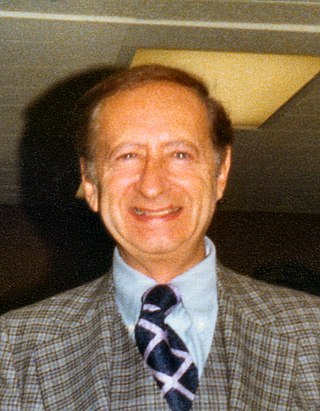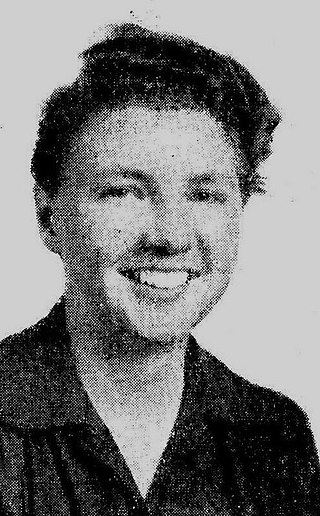Related Research Articles

Fahrenheit 451 is a 1953 dystopian novel by American writer Ray Bradbury. It presents an American society where books have been personified and outlawed and "firemen" burn any that are found. The novel follows Guy Montag, a fireman who becomes disillusioned with his role of censoring literature and destroying knowledge, eventually quitting his job and committing himself to the preservation of literary and cultural writings.

Hannes Bok, pseudonym for Wayne Francis Woodard, was an American artist and illustrator, as well as an amateur astrologer and writer of fantasy fiction and poetry. He painted nearly 150 covers for various science fiction, fantasy, and detective fiction magazines, as well as contributing hundreds of black and white interior illustrations. Bok's work graced the pages of calendars and early fanzines, as well as dust jackets from specialty book publishers like Arkham House, Llewellyn, Shasta Publishers, and Fantasy Press. His paintings achieved a luminous quality through the use of an arduous glazing process, which was learned from his mentor, Maxfield Parrish. Bok shared one of the inaugural 1953 Hugo Awards for science fiction achievement.

Ray Douglas Bradbury was an American author and screenwriter. One of the most celebrated 20th-century American writers, he worked in a variety of genres, including fantasy, science fiction, horror, mystery, and realistic fiction.

Robert Albert Bloch was an American fiction writer, primarily of crime, psychological horror and fantasy, much of which has been dramatized for radio, cinema and television. He also wrote a relatively small amount of science fiction. His writing career lasted 60 years, including more than 30 years in television and film. He began his professional writing career immediately after graduation from high school, aged 17. Best known as the writer of Psycho (1959), the basis for the film of the same name by Alfred Hitchcock, Bloch wrote hundreds of short stories and over 30 novels. He was a protégé of H. P. Lovecraft, who was the first to seriously encourage his talent. However, while he started emulating Lovecraft and his brand of cosmic horror, he later specialized in crime and horror stories working with a more psychological approach.

The Illustrated Man is a 1951 collection of 18 science fiction short stories by American writer Ray Bradbury. A recurring theme throughout the stories is the conflict of the cold mechanics of technology and the psychology of people. It was nominated for the International Fantasy Award in 1952.

Leigh Douglass Brackett was an American science fiction writer known as "the Queen of Space Opera." She was also a screenwriter, known for The Big Sleep (1946), Rio Bravo (1959), and The Long Goodbye (1973). She worked on an early draft of The Empire Strikes Back (1980), elements of which remained in the film; she died before it went into production. In 1956, her book The Long Tomorrow made her the first woman ever shortlisted for the Hugo Award for Best Novel, and, along with C. L. Moore, one of the first two women ever nominated for a Hugo Award. In 2020, she posthumously won a Retro Hugo for her novel The Nemesis From Terra, originally published as Shadow Over Mars.

Gregory Dale Bear was an American writer and illustrator best known for science fiction. His work covered themes of galactic conflict, parallel universes, consciousness and cultural practices, and accelerated evolution. His most recent work was the 2021 novel The Unfinished Land. Greg Bear wrote over 50 books in total.

William Francis Nolan was an American author who wrote hundreds of stories in the science fiction, fantasy, horror, and crime fiction genres.

Raymond Frederick Harryhausen was an American-British animator and special effects creator who created a form of stop motion model animation known as "Dynamation". His works include the animation for Mighty Joe Young (1949) with his mentor Willis H. O'Brien ; his first color film, The 7th Voyage of Sinbad (1958); and Jason and the Argonauts (1963), which featured a sword fight with seven skeleton warriors. His last film was Clash of the Titans (1981), after which he retired.

Other Worlds, Universe Science Fiction, and Science Stories were three related US magazines edited by Raymond A. Palmer. Other Worlds was launched in November 1949 by Palmer's Clark Publications and lasted for four years in its first run, with well-received stories such as "Enchanted Village" by A. E. van Vogt and "Way in the Middle of the Air", one of Ray Bradbury's "Martian Chronicle" stories. Since Palmer was both publisher and editor, he was free to follow his own editorial policy, and presented a wide array of science fiction.

The October Country is a 1955 collection of nineteen macabre short stories by American writer Ray Bradbury. It reprints fifteen of the twenty-seven stories of his 1947 collection Dark Carnival, and adds four more of his stories previously published elsewhere.

It Came from Outer Space is a 1953 American science fiction horror film, the first in the 3D process from Universal-International. It was produced by William Alland and directed by Jack Arnold. The film stars Richard Carlson and Barbara Rush, and features Charles Drake, Joe Sawyer, and Russell Johnson. The script is based on Ray Bradbury's original film treatment "The Meteor" and not, as sometimes claimed, a published short story.

Dennis William Etchison was an American writer and editor of fantasy and horror fiction. Etchison referred to his own work as "rather dark, depressing, almost pathologically inward fiction about the individual in relation to the world". Stephen King has called Dennis Etchison "one hell of a fiction writer" and he has been called "the most original living horror writer in America".

The Flying Sorcerers is a humorous 1971 science fiction novel by American writers David Gerrold and Larry Niven. It was originally serialized in 1970 as The Misspelled Magishun in If magazine.

The Wonderful Ice Cream Suit is a 1998 American fantasy comedy film directed by Stuart Gordon, written by Ray Bradbury and starring Edward James Olmos, Joe Mantegna, Esai Morales, Clifton Collins Jr., Sid Caesar, Howard Morris and Gregory Sierra. It is set in East Los Angeles.
"The Pedestrian" is a science fiction short story by American writer Ray Bradbury. This story was originally published in the August 7, 1951 issue of The Reporter by The Fortnightly Publishing Company. It is included in the collection The Golden Apples of the Sun (1953), but was dropped from later editions of this collection.
"The Veldt" is a science fiction short story by American author Ray Bradbury. Originally appearing as "The World the Children Made" in the September 23, 1950, issue of The Saturday Evening Post, it was republished under its current name in the 1951 anthology The Illustrated Man.
"The Aqueduct (A Martian Chronicle)" is a short story by American writer Ray Bradbury. Originally released as a limited edition chapbook, the story was subsequently collected in The Stories of Ray Bradbury in 1980.

The Illustrated Man is a 1969 American dark science fiction drama film directed by Jack Smight and starring Rod Steiger as a man whose tattoos on his body represent visions of frightening futures. The film is based on three short stories from the 1951 collection The Illustrated Man by Ray Bradbury: "The Veldt," "The Long Rain," and "The Last Night of the World."

The Ogre's Wife: Fairy Tales for Grownups is a collection of fantasy short stories by American writer Richard Parks. It was first published in trade paperback by Obscura Press in August 2002. A Kindle edition was issued in 2011, and a new trade paperback edition in September 2020. The collection was nominated for the 2003 World Fantasy Award for Best Collection; its title story won the SF Age Reader's Poll for short story in 1995.
References
- ↑ Summary and Analysis: The October Country Jack-in-the-Box . Retrieved March 13, 2014.
{{cite book}}:|work=ignored (help) - ↑ Eller, Jonathan R.; Touponce, William F.; Nolan, William F. (Foreword) (May 24, 2004). Ray Bradbury: The Life of Fiction (Hardcover). Kent State University Press. pp. 320. ISBN 0873387791 . Retrieved March 13, 2014.
Ray Bradbury's Jack in the Box.